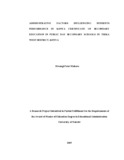| dc.description.abstract | The purpose of this study was to investigate the administrative factors that
influence students performance at KCSE public day secondary schools Thika
West, District. Kiambu County, Kenya. This study sought to determine the extent
to which Head teacher’s competence in inducting new teachers, benchmarking,
and administration of standardized examinations and syllabus coverage influence
students’ performance in KCSE. This study adopted ex-post facto research design.
The target population included 38 secondary schools, 38 head teachers and 760
teachers. The sample was 14 head teachers and 56 teachers in 14 public day
secondary schools in Thika West District. Kiambu County. A purposive sampling
technique was used to select 14 public day secondary schools. Data was collected
using two sets: headteachers’ and teachers’ questionnaires which had a reliability
coefficient of 0.81. The data for headteachers and teachers was collected and
presented in tables and line graphs. Various descriptive statistic like frequencies,
percentages and tables were used to arrive at conclusions. The findings indicated
that where induction of new teachers is done the m.s.s. trends are 5.1, 4.8, 4.9,
4.691 and 4.667. Where it was not done the m.s.s. trends are 3.2, 3.0, 2.984, 2.789
and2.475. Also where benchmarking was done the m.s.s. trends were 4.9, 3.7,
3.79, 4.231 and 4.393. In schools that administered standardized exams the m.s.s
trends were 4.4, 4.4, 3.79, 4.23 and 4.393 and where not done the m.s.s trends
were 3.4, 3.0, 2.24, 2.25 and 2.754. In schools where there was early coverage of
syllabus, the m.s.s trends were 2.1, 2.1, 3.057, 4.0 and 4.051 where not done the
m.s.s trends were 2.0, 2.7, 2.25, 2.143 and 2.350. In schools where there was
regularization of instructional supervisions, the m.s.s trends were 5.1, 4.8, 4.9, 4.6
and 4.6 again whereas schools that did not practice the m.s.s trends were 3.6, 3.1,
3.8, 3.5 and 3.6. The finding lead to the conclusion that indeed induction of
teachers, benchmarking, early syllabus coverage and regular administration of
standardized examinations helps in improving student performance in KCSE. The
study recommends that head teachers be required to take mandatory courses in
education, administration and seek further guidance from experts of Kenya
Educational Management Institute (KEMI) to enable them to manage schools
more effectively and efficiently. Also, schools should embrace benchmarking
with other well performing schools, encourage early syllabus coverage, and
embrace administration of standardized examinations. See table 4.3, 4.4, 4.5, 4.6,
4.7 and 4.6. Also, teachers should design induction and orientation sessions for
teachers in their schools and not to leave them find their own way in the school. | en_US |

